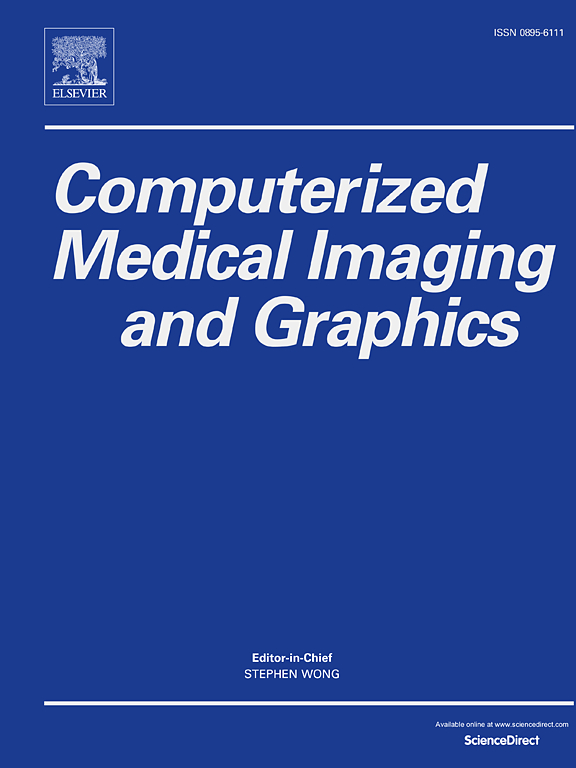UniBrain: Universal Brain MRI diagnosis with hierarchical knowledge-enhanced pre-training
IF 5.4
2区 医学
Q1 ENGINEERING, BIOMEDICAL
Computerized Medical Imaging and Graphics
Pub Date : 2025-03-07
DOI:10.1016/j.compmedimag.2025.102516
引用次数: 0
Abstract
Magnetic Resonance Imaging (MRI) has become a pivotal tool in diagnosing brain diseases, with a wide array of computer-aided artificial intelligence methods being proposed to enhance diagnostic accuracy. However, early studies were often limited by small-scale datasets and a narrow range of disease types, which posed challenges in model generalization. This study presents UniBrain, a hierarchical knowledge-enhanced pre-training framework designed for universal brain MRI diagnosis. UniBrain leverages a large-scale dataset comprising 24,770 imaging-report pairs from routine diagnostics for pre-training. Unlike previous approaches that either focused solely on visual representation learning or used brute-force alignment between vision and language, the framework introduces a hierarchical alignment mechanism. This mechanism extracts structured knowledge from free-text clinical reports at multiple granularities, enabling vision-language alignment at both the sequence and case levels, thereby significantly improving feature learning efficiency. A coupled vision-language perception module is further employed for text-guided multi-label classification, which facilitates zero-shot evaluation and fine-tuning of downstream tasks without modifying the model architecture. UniBrain is validated on both in-domain and out-of-domain datasets, consistently surpassing existing state-of-the-art diagnostic models and demonstrating performance on par with radiologists in specific disease categories. It shows strong generalization capabilities across diverse tasks, highlighting its potential for broad clinical application. The code is available at https://github.com/ljy19970415/UniBrain.
UniBrain:基于分层知识增强预训练的通用脑MRI诊断
磁共振成像(MRI)已成为诊断脑部疾病的关键工具,人们提出了一系列计算机辅助人工智能方法来提高诊断准确性。然而,早期的研究往往受到小规模数据集和狭窄疾病类型范围的限制,这给模型泛化带来了挑战。本研究提出了UniBrain,一个分层知识增强的预训练框架,设计用于通用脑MRI诊断。UniBrain利用由24,770对来自常规诊断的成像报告组成的大规模数据集进行预训练。与之前的方法不同,该框架引入了分层对齐机制,这些方法要么只关注视觉表示学习,要么在视觉和语言之间使用蛮力对齐。该机制从多个粒度的自由文本临床报告中提取结构化知识,使序列和病例级别的视觉语言对齐,从而显着提高特征学习效率。采用耦合的视觉语言感知模块进行文本引导的多标签分类,在不修改模型架构的情况下,便于对下游任务进行零采样评估和微调。UniBrain在域内和域外数据集上进行了验证,不断超越现有的最先进的诊断模型,并在特定疾病类别中展示了与放射科医生相当的性能。它在不同的任务中显示出强大的泛化能力,突出了其广泛临床应用的潜力。代码可在https://github.com/ljy19970415/UniBrain上获得。
本文章由计算机程序翻译,如有差异,请以英文原文为准。
求助全文
约1分钟内获得全文
求助全文
来源期刊
CiteScore
10.70
自引率
3.50%
发文量
71
审稿时长
26 days
期刊介绍:
The purpose of the journal Computerized Medical Imaging and Graphics is to act as a source for the exchange of research results concerning algorithmic advances, development, and application of digital imaging in disease detection, diagnosis, intervention, prevention, precision medicine, and population health. Included in the journal will be articles on novel computerized imaging or visualization techniques, including artificial intelligence and machine learning, augmented reality for surgical planning and guidance, big biomedical data visualization, computer-aided diagnosis, computerized-robotic surgery, image-guided therapy, imaging scanning and reconstruction, mobile and tele-imaging, radiomics, and imaging integration and modeling with other information relevant to digital health. The types of biomedical imaging include: magnetic resonance, computed tomography, ultrasound, nuclear medicine, X-ray, microwave, optical and multi-photon microscopy, video and sensory imaging, and the convergence of biomedical images with other non-imaging datasets.

 求助内容:
求助内容: 应助结果提醒方式:
应助结果提醒方式:


